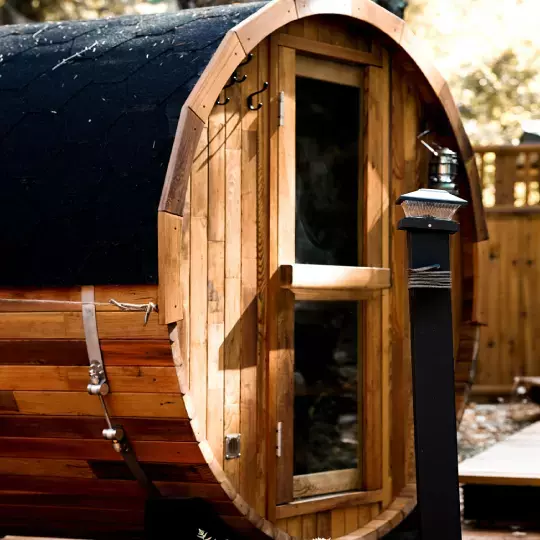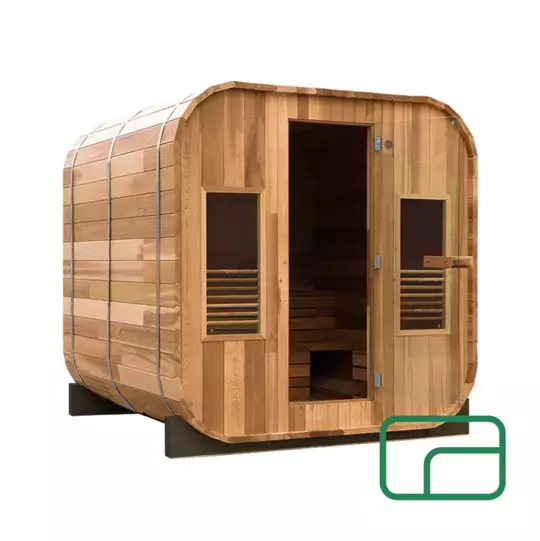Cedar vs hemlock: What wood to use for sauna construction?
In the red corner - Canadian Red Cedar, known for its strength and stunning natural aroma.

And in the even redder corner of the sauna – Canadian Hemlock. The smooth, stylish and durable alternative.
Which of these two woods wins the contest to find which wood to build a sauna is best? And which of the two thrives most in the red hot heat of a sauna session?
Seconds out, you’re about to find out as we take a closer look at the top two contenders for the title of best wood for sauna construction. It’s hemlock vs cedar.
Red cedar in sauna construction
When it comes to what wood to build a sauna with, a wood that can handle the heat, humidity and moisture of a sauna - like red cedar - is tough to beat.
Cedar is a dark, slightly reddy-browny looking wood with a straight grain, smooth texture and premium appearance.
Lightweight and soft to the touch, it’s fair to say that this is the champion of champions when it comes to wood for both infrared and traditional Finnish saunas.
It thrives in intense humidity and high temperatures, refusing to dry out, warp or crack, while obstinately retaining its shape no matter the heat.
Even better, cedar actually enhances the sauna experience by giving off an aroma that’s not only easy on the nose, but also has pro-health and wellness properties. And you can even build an outdoor sauna using cedar, as it handles all kinds of weather.
Upsides:
- Resists rot and decay
- Gives off a pleasant smell
- Requires minimal maintenance or treatment
- Effective natural insulator
Downsides:
- Pricey when compared to other woods including hemlock
- You may not be fan of the aroma it gives off
How red cedar handles heat and moisture
Red cedar wood contains natural oils which keep it moist when things get heated, handy when there’s lots of humidity around. The wood stays free from cracks, warps and signs of rotting no matter how often you use a sauna.
Those natural oils have a secondary benefit – they’re an effective insect repellent, stopping the critters from breathing or laying eggs. So you won’t be joined in your sauna by unwelcome guests such as termites, ants or mosquitoes.
Red cedar and your health: Aromatherapy and wellness effects
The natural oils in cedar wood give off a pleasant aroma with health-giving properties. They also boost the relaxation and detoxification you’ll experience during a sauna session.
Science boffins have discovered that the healthy scent cedar gives off is down to compounds called thujaplicin. That word’s a bit of a mouthful to pronounce, but knowledge of it is something to impress friends with the next time you all gather for a sauna session.
Other wellness effects Canadian red cedar is known to support and produce include:
- Increased mental clarity
- Reduced stress
- Boost to skin health
- Benefits to your respiratory system
- Air-purifying and antimicrobial properties
What makes hemlock a sauna-ready wood?
Now onto the challenger for what wood to use for saunas. Hemlock is a smooth, clean looking light brown/golden wood with fewer of those dark knots you find in other types of wood. Like cedar, it won’t rot or warp easily, although it’s considered less durable than its counterpart and will require a bit more maintenance than cedar.
Upsides:
- Less expensive than cedar
- Warp and rot resistant
- No aroma
Downsides:
- Not as durable as cedar
- Has been known to splinter
What is thermo hemlock?
This is hemlock that has been heat treated to boost the stability of the wood and increase its resistance to the effects of moisture and heat. As you might expect, the thermal modification process boosts the wood’s thermal performance.
How hemlock handles temperature and moisture fluctuations
Hemlock is best suited for indoor saunas, although it doesn’t pack as many natural defences against moisture as cedar, so will need treating to reduce the damage caused by high moisture and humidity.
Hemlock and health: Pros, cons, and neutrality
Hemlock is often the recommended wood for a sauna if you’re sensitive or allergic to the natural oils and scents given off by red cedar. This is your hypoallergenic alternative, a neutral and reliable option that’s not as durable as cedar, but not as expensive either.
Final verdict: Hemlock vs. red cedar for your sauna
When it comes to hemlock vs cedar sauna construction, while it’s far from being a ‘no-contest’, red cedar is the clear winner.
It’s the most durable wood for sauna construction. Its natural ability to handle the hot and moist conditions that are rife in saunas is unmatched, and it’s proved its worth in infrared and traditional saunas time and time again.
Hemlock has its fans, though, especially those looking for a less costly alternative. And it’s a wood that doesn’t give off aromas like red cedar.
Here at Cosy Deals, we offer saunas made from both types of wood, which we believe are the top two woods for sauna construction. Other types of wood such as Nordic Spruce, Basswood, Aspen and Eucalyptus are all perfectly decent materials to use for sauna construction, but none are as strong all-round performers as red cedar or hemlock.
Discover our saunas
Why not take a look at our range of indoor and outdoor traditional red cedar vs hemlock saunas. And now that you know the advantages and disadvantages of each type of wood, you’ll be able to choose hemlock or cedar for sauna perfection.
Here are some examples of just a few of the saunas for sale at Cosy Deals that are made from either red cedar or hemlock:
Classic traditional wood burning sauna
- Thermo Hemlock: $7531
- Red cedar: $8326
Barrel design wood-fired sauna
- Thermo Hemlock: $7056
- Red cedar: $7611
European-powered cube sauna
- Thermo Hemlock: $8000
- Red cedar: $8175
To see all of our premium quality saunas for sale, head over to this page.




